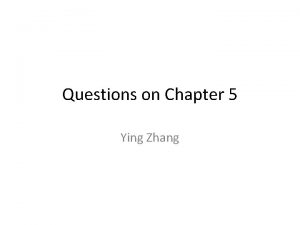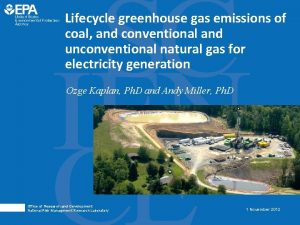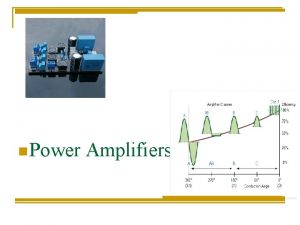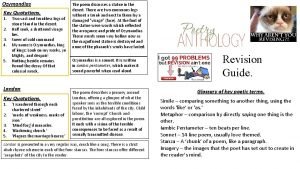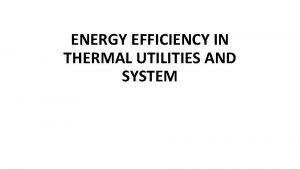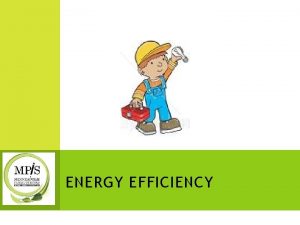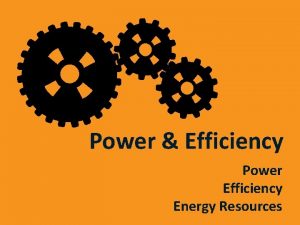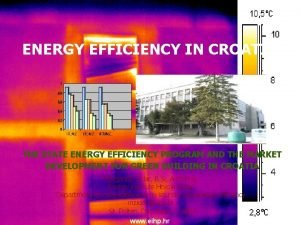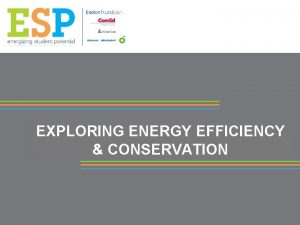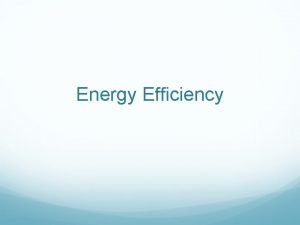Power and Efficiency Energy and efficiency g show
















- Slides: 16

Power and Efficiency

Energy and efficiency • (g) show an understanding and use the relationship between force and potential energy in a uniform field to solve problems • (j) show an understanding of the concept of internal energy • (k) show an appreciation for the implications of energy losses in practical devices and use the concept of efficiency to solve problems

Efficiency • • Useful energy out / total energy in Always less than 1 Often quoted as percentage Can be represented on a Sankey diagram see p 65

To do • Energy calculations worksheet

Power • (l) define power as work done per unit time and derive power as the product of force and velocity • m) solve problems using the relationships P = Work/time and P = Fv.

Power • Power is the rate at which work is done • i. e. the rate at which energy is transferred by a force. • Work done/time

Power and Velocity • Since W = F. s • And power P = W t • Then P = Fs t • s = velocity t • So P = F. v • Look at the units

Topic questions Work, energy and power

Thinking • A child is playing with a nearly frictionless car down a smooth flexible track. She arranges the identical length of track in two ways. • In both arrangements the track runs from the same place on the edge of a table to floor level.

Questions • 1. She thinks that the car runs off the track at very nearly the same speed in both arrangements when started from rest at the top of the track (the point nearest the table). Is she right or wrong? Give a reason for your answer. • 2. She thinks the car takes longer to run down the top arrangement than down the bottom arrangement, when started from rest at the top of the track. Is she right or wrong? Again, justify your answer. • 3. Suppose she now lets a car of twice the mass of the previous one run from rest down the top arrangement. Will this car, which has twice as great a mass, take a shorter, the same, or a longer time to run down the track? Give a reason for your answer.

Answers • 1. Right, as both cars have the same amount of kinetic energy on leaving the track. A good answer would relate this to the same drop in height, explicitly equating the change in potential energy to the change in kinetic energy. • 2. Right, as the bottom arrangement gains kinetic energy more quickly, making the average speed greater. A good answer would relate this more rapid change in kinetic energy to the steepness of the slope–top arrangement gets faster sooner! • 3. Same, assuming the frictional forces are really negligible as the change in kinetic energy equated to the change in potential energy soon gives:

The high jump – energy changes • Note: g = 9. 8 N kg-1 = 9. 8 m s-2 • 1 A jumper of mass 75 kg jumps a height of 1. 9 m • (a) Calculate the gravitational potential energy of the jumper at his highest point. • (b) Calculate the vertical velocity of the jumper just before impact with the crash mat. (HINT: what was the vertical velocity of the jumper at the top of his jump? ) • (c) Show that the kinetic energy associated with his vertical velocity is equal to the gravitational potential energy at the top of his jump. • (d) The jumper is stopped over a distance of 0. 3 m when he lands on the crash mat. Calculate the average force on the jumper as he comes to rest.

Answers • The high jump • 1) • (a) Gravitational potential energy = mgh = 70 x 9. 8 x 1. 9 = =1303. 4 J = 1300 J to 2 sf as required by the data • (b) v 2 = u 2 + 2 as u = 0 so v = (2 x 9. 8 x 1. 9)0. 5 so v = 6. 1 m s-1 • (c) ½ m v 2 = 1302 J = 1300 J to 2 sf (a circular argument, of course) which emphasises that the suvat equation used in part (b) is derived from conservation of energy • (d) Fs = 1304 J so F = 1304/0. 3 =4345 N = 4300 N to 2 sf

To do • Energy calculations worksheet

Reading • P 60 -66 p 4 u

To do • Physics for you • P 67 q 3, 4, 6, 7, 8 • P 108 q 36, 37, 40 -43
 Renewable energy and energy efficiency partnership
Renewable energy and energy efficiency partnership Allocative efficiency and productive efficiency
Allocative efficiency and productive efficiency Draw the power triangle
Draw the power triangle Productively efficient vs allocatively efficient
Productively efficient vs allocatively efficient Productively efficient vs allocatively efficient
Productively efficient vs allocatively efficient Consider three lans interconnected by two routers
Consider three lans interconnected by two routers Energy energy transfer and general energy analysis
Energy energy transfer and general energy analysis Energy energy transfer and general energy analysis
Energy energy transfer and general energy analysis Work power and efficiency
Work power and efficiency Natural gas power plant efficiency
Natural gas power plant efficiency Food efficiency ratio
Food efficiency ratio Which power amplifier has the highest collector efficiency
Which power amplifier has the highest collector efficiency Quotations for poem ozymandias
Quotations for poem ozymandias Seec saudi
Seec saudi Energy efficiency
Energy efficiency Energy efficiency in thermal utilities
Energy efficiency in thermal utilities Taiwan energy efficiency label
Taiwan energy efficiency label





